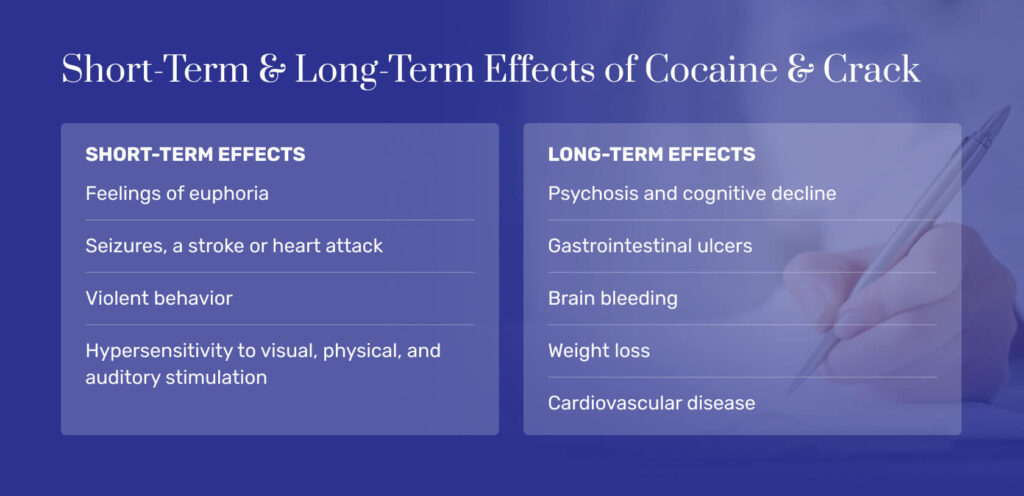Cocaine is a powdered drug that users typically snort. Crack is a glass-like form of cocaine users typically heat and inhale.
| Cocaine | Crack | |
|---|---|---|
| Composition | Hydrochloride salt | Cocaine combined with water, baking soda, and other inert ingredients |
| Appearance | Powder | Clear, glass-like substance |
| Duration | 30 minutes | 10 minutes |
Crack vs. Cocaine
Several important factors separate cocaine from crack. The list below isn’t exhaustive, as far more differences exist. But reading through this information can help you understand why they’re such unique substances, even though they share chemical properties.
Chemical Makeup & Appearance
Cocaine’s active ingredient is hydrochloride salt — a natural substance distilled from the leaves of the South American coca plant. Dealers often mix the salt with substances like talcum or flour to increase their profits. They sell the mixture in powdered form.[1]
Crack contains powdered cocaine mixed with water and ammonia or baking soda. The solution is boiled until it achieves a solid, glass-like state. Dealers sell the shards (or rocks) as crack.[2]
Method of Use
Most cocaine users snort the powder with a straw. The drug interacts with blood vessels lining the nose, entering the bloodstream and brain minutes later. Some people mix cocaine with water and inject the solution, but that’s less common than snorting.
Crack cocaine is almost always smoked. Users place a rock on a small piece of foil, heat the metal, and inhale the vapors through a straw. The drug enters the bloodstream through the lungs.

Onset & Duration of Effects
The effects of cocaine will generally set in for users within minutes and last up to 30 minutes. Crack users will experience a high that begins fairly immediately (within 15 to 30 seconds) and lasts anywhere from 5 to 10 minutes.[3]
30 minutes
Average duration of cocaine’s effects.
10 minutes
Average duration of crack’s effects.
Short-Term Effects
Both cocaine and crack can cause short-term issues, including the following:[3]
Loss of inhibition
Euphoria
Hypersensitivity to visual, physical, and auditory stimulation
Anorexia
Heart attack
Violent behavior
Seizures
Stroke
In rare cases, people have died the first time they used cocaine or crack. Both substances are toxic to heart muscles and can cause sudden death.[3]
Short-term effects of snorting cocaine can include nosebleeds and voice chances. Short-term problems associated with smoking crack can include coughing due to bronchial irritation.
Long-Term Health Risks
Both cocaine and crack can cause long-term issues, including the following:[4]
Negative moods between doses
Tolerance (meaning more cocaine is required to get high)
Higher overdose risks
Psychosis
Gastrointestinal ulcers
Weight loss
Cardiovascular disease
Stroke
Blain bleeding
Cognitive decline
Snorting cocaine regularly can lead to the following issues:[4]
Loss of smell
Nosebleeds
Voice changes
Running nose
Smoking crack cocaine can damage the lungs and make asthma symptoms worse.[4]
Addiction Potential
Both cocaine and crack are extremely addictive. But crack’s quick action and rapid decline makes it even more dangerous.
Crack users subject their brains to a whipsaw of big highs and low lows. It’s possible that crack is more addictive as a result.
Cutting Agents & Additives
Crack and cocaine both contain inert ingredients. Even cocaine sold as “pure” often contains additives like talc, powdered milk, and flour.
Crack contains these elements too, as it’s derived from cocaine. But it also contains traces of ammonia (in some cases) or baking soda.
Cost
The United Nations Office on Drugs and Crime estimates that cocaine salts cost $120 per gram on the street in 2019. Crack was much less expensive at $80 per gram.[5]
$120 per gram
Average street price of powdered cocaine (2019)
$80 per gram
Average street price of crack cocaine (2019)
Crack’s affordability makes it a dangerous addition to any community. If users can afford the drug and believe it packs a euphoric high, they generally use it more.
Legal Status & Sentencing Disparities
Powdered cocaine has very limited pharmaceutical uses, including numbing eye tissues before surgery. Crack has no such use. But abusing either form of the drug is illegal.
18X
A sentence for crack cocaine is 18 times longer than for powdered cocaine. Many organizations, including the ACLU, view this as a clear example of systemic racism.
If you’re caught holding or using any form of cocaine, law enforcement can get involved. But your sentence can vary, depending on the type you have.
Right now, a sentence for crack is 18 times larger than one for powdered. For many organizations, including the American Civil Liberties Union, this represents systemic racism.[6]
African Americans represent the largest user base for crack cocaine. Sentencing disparities are responsible, at least in part, for high incarceration rates for people in this community.
Abuse & Addiction Statistics
Organizations like the Substance Abuse and Mental Health Services Administration don’t separate crack and powdered cocaine when measuring use. As a result, it’s nearly impossible to determine which is more popular. And it could vary from one part of the country to another.
Overall, 968,000 people 12 and older initiated cocaine use for the first time in 2015.[7]
Misconceptions About Crack & Cocaine
One popular myth that has circulated is that crack is more damaging and more addictive than cocaine, which is unproven. Both forms of the drug are highly addictive and result in similar long-term damage to the brain and body.
Another myth is that cocaine heightens sexual experiences. Cocaine makes high-risk sex more likely, but in the long term, cocaine use can lead to impotence and an overall loss of interest in sex.


Signs of Crack Cocaine Abuse
Treatment for Crack & Cocaine Addiction
Treatment approaches are generally going to be the same for crack and cocaine abuse. Comprehensive treatment will give you the best chance at a full recovery, as you’ll receive therapies that cater to your personal needs.
Your treatment options might include the following:
Medical detox, so you can get sober in a safe and protected environment
Inpatient rehab, so you can step away from your triggers and build up your relapse prevention skills in a safe and comfortable environment
Partial hospitalization programs, so you can address physical issues as well as mental health problems in treatment
Intensive outpatient programs, so you can spend all day in treatment while living at home
Outpatient care, so you can live at home while working on your addiction
It’s common to move between these modes of treatment. For example, you might start in medical detox, move to inpatient rehab, and then try outpatient care. Your team can guide your care, and treatment intensity will vary as you get stronger in your recovery.
- What is cocaine? National Institute on Drug Abuse. Published May 2016. Accessed July 28, 2023.
- Crack cocaine fast facts. National Drug Intelligence Center. Published April 2003. Accessed July 28, 2023.
- What are the short-term effects of cocaine use? National Institute on Drug Abuse. Published May 2016. Accessed July 28, 2023.
- What are the long-term effects of cocaine use? National Institute on Drug Abuse. Published May 2016. Accessed July 28, 2023.
- Price and purity. United Nations Office on Drugs and Crime. Accessed July 28, 2023.
- Fair sentencing act. American Civil Liberties Union. Accessed July 28, 2023.
- Hughes A, Williams M, Lipari R, Van Horn S. State estimates of past year cocaine use among young adults: 2014 and 2015. Substance Abuse and Mental Health Services Administration. Published December 20, 2016. Accessed July 28, 2023.











